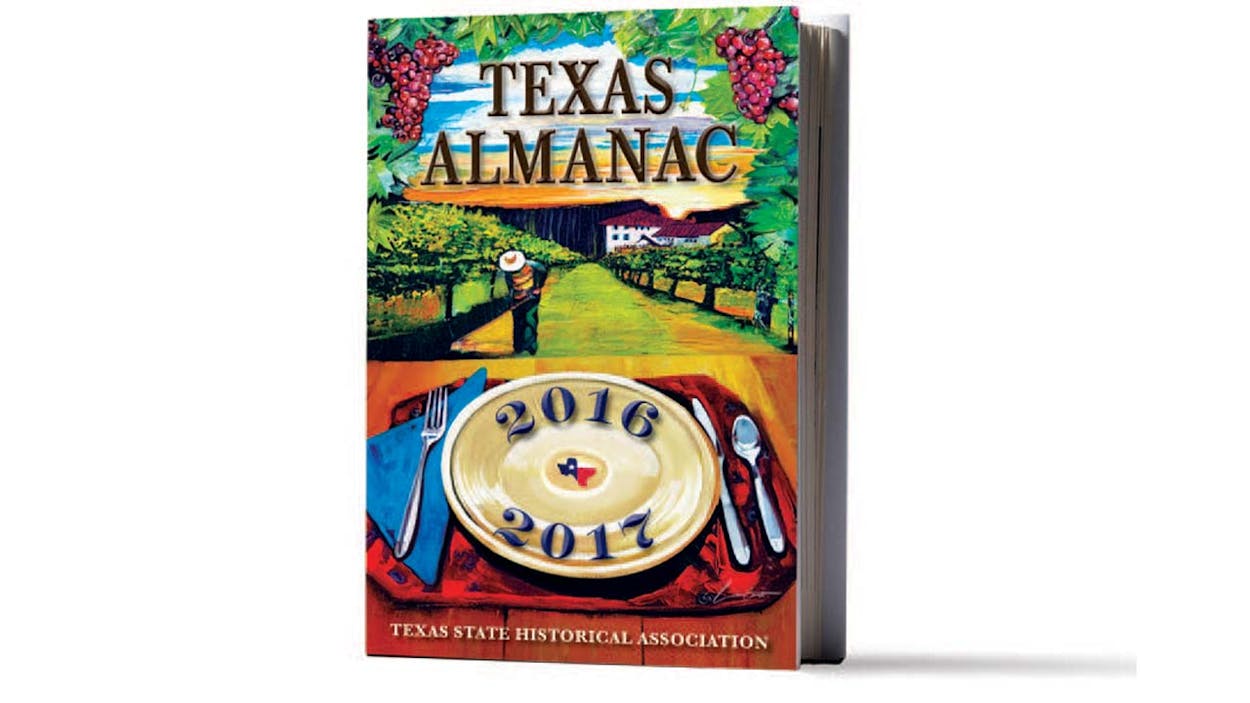Quick: (1) What is Texas’s official state cooking implement? (2) Who won the 1974 high school football state championship game in the six-man division? (3) What is the state’s most visited destination?
The answers to those questions—and many, many others—can be found in the brand-new edition of the Texas Almanac, a compendium of geographical, historical, and statistical data published every two years by the Texas State Historical Association. “It chronicles a moment in time,” editor Elizabeth Cruce Alvarez says, likening the almanac, and its companion website, which includes archives of nearly every edition, to a state yearbook. “Websites are constantly changing—they update their facts, and a lot of times they don’t keep the older stuff. But with each almanac, going back to 1857, you’ve got a slice of time that says, ‘This is how stuff was right then.’ ”
The almanac was the brainchild of Willard Richardson, the editor of the Galveston News, who in 1857 decided to document the history of the young state—the first guides included personal accounts of the Texas Revolution—and explain to newcomers how state government worked. Some early editions were called the Texas Almanac and Emigrant’s Guide to Texas.
The almanac has grown from Richardson’s 158-page booklet to a 752-page tome, but it’s no less relevant to the hundreds of thousands of newcomers moving here every year. Alvarez, who offices in Southlake, and associate editor Robert Plocheck, who’s based in Austin, spend the better part of two years collecting data about state parks, tax revenues, agricultural products, crime, and weather extremes, as well as putting together maps, summaries of Texas history, and notes on the most recent legislative session. The book even includes a pronunciation guide (it’s Bur-net, durn it, not Bur-net).
Some facts, like the highest elevation (Guadalupe Peak), don’t change. Others, of course, vary over time (between 2000 and 2010, the number of Muslims in Texas increased by more than 300,000, making Islam the fifth-largest religious affiliation in the state—surpassing the Church of Christ and the Presbyterian and Lutheran churches). Even the terms used in data collection change, often to reflect shifting attitudes. For instance, early almanacs list the number of “insane” people in the state. Nowadays the almanac uses less pejorative phrases, such as “schizophrenia” and “bipolar and mood disorders.”
The almanac, Alvarez says, is an indispensable reference for reporters, academics, and middle school students studying Texas history. She remembers a professor who figured out how many women were involved in Texas county government in the twenties and thirties by searching the online archives for the names of county officials, who at that time were identified by “Miss” or “Mrs.” if they were women. But the almanac has broader applications: A researcher for the 2007 film Charlie Wilson’s War resolved her quest for a map of the state’s mid-eighties congressional districts in its pages. Hunters use the book’s astronomical calendar to plan trips around sunrise and sunset times. Attorneys have employed the same data to determine whether the sun set when a witness said it did.
One group that doesn’t browse the almanac is incarcerated Texans (total population: 150,361 as of August 2014). The book’s highly detailed county-by-county maps, showing roads, towns, railroads, and rivers, are considered escape paraphernalia by the Texas Department of Criminal Justice. “That’s a compliment,” Alvarez says proudly.
Each edition contains a gathering of fresh feature articles, usually organized around a single theme. In past years, these have included Texas artists, historic ranches, and the Austin music scene. The new edition focuses on food and drink, which are undergoing something of a renaissance in Texas. Though the almanac notes how hard it has gotten to find a good chicken-fried steak these days, it does celebrate the emergence of wineries in nearly every region of the state. Which raises another question: (4) How many wineries are there in Texas? You could look it up.
Answer key: (1) The cast-iron Dutch oven, as established by the Seventy-ninth Legislature in 2005. (2) Marathon, over Cherokee, 60–58. (3) The Alamo, every year, always. (More surprising: according to the most recent study, which was done in 2011, the San Marcos Outlet Malls have bumped the Capitol from the number six slot. Cry for Texas.) (4) More than two hundred.
- More About:
- Texas History
- Books







